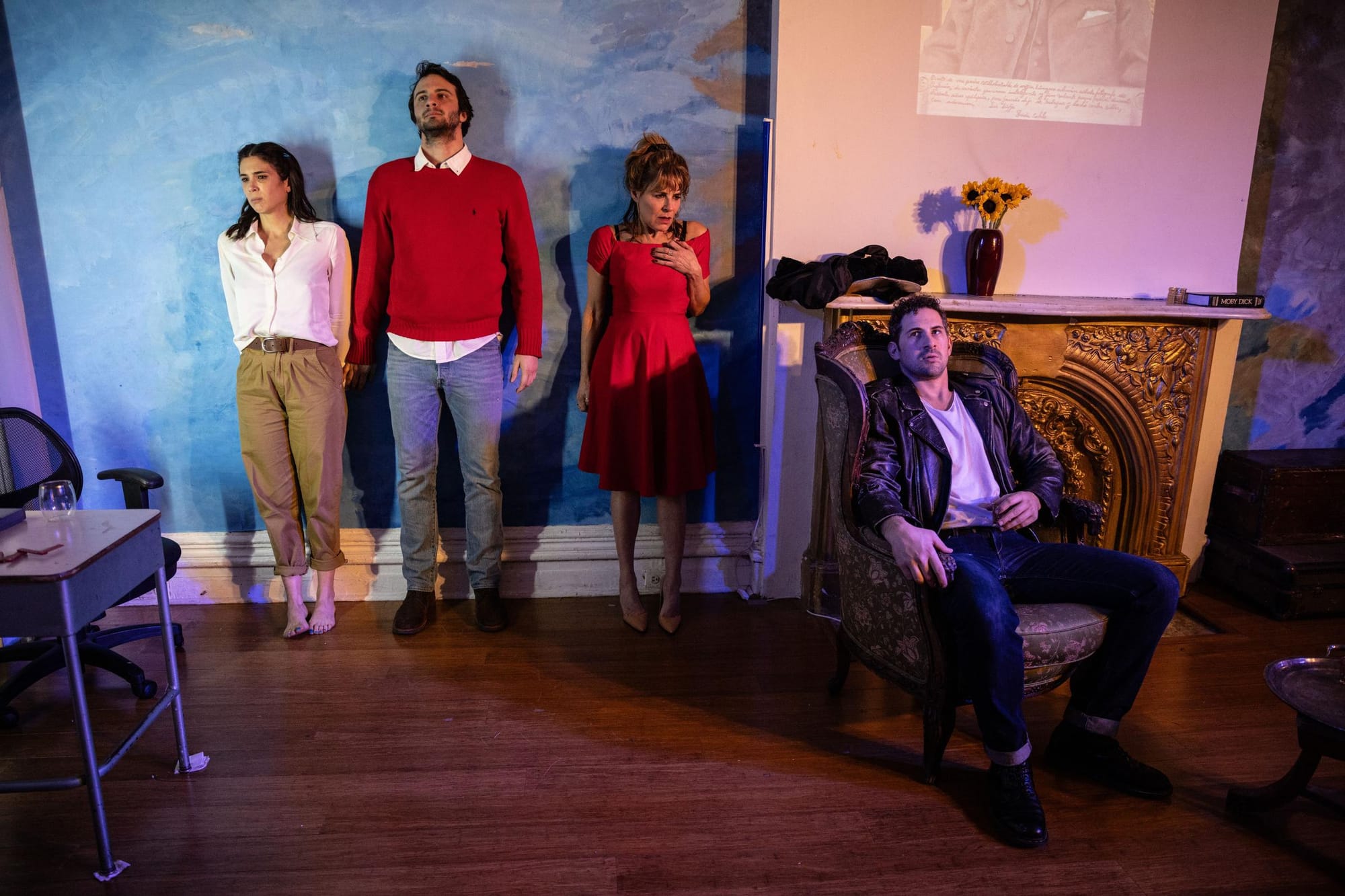The Whole of Time
Torn Page
435 W 22nd St.
New York City
Through Jan. 27, 2024
There’s something about a living room play. You know the kind: An ostensibly ordinary family sits at home, usually in the same room, talking for hours until they’re faced with the staggering reality of how dysfunctional they truly are. It’s gritty and claustrophobic and also bleakly funny. There’s a three-sided interior set and a fourth wall that doesn’t get broken. The realism of it all is the appeal. In The Whole of Time at the Torn Page, a three-story townhouse in Chelsea with a parlor-turned-performance space, the living room becomes the stage.
When I got to the Torn Page, I hung up my coat in the front hall. The theater was on the second floor, at the top of a set of winding stairs. On the way up, I clocked the shrine to Frida Kahlo staged in the stairwell’s niche, wondering if it was show-specific or just perennial decor (the former). By the time I shuffled past the tiny pre-show bar and wormed my way into my seat, I was already starting to feel the forced proximity.
With The Whole of Time, that hyper-intimacy is a major selling point. Staged by director Tony Torn for an audience capped at 22, the show offers the potential to deliver realism at its most voyeuristic. (The fact that the townhouse was once home to Torn’s late parents, the actors Rip Torn and Geraldine Page, only adds an extra layer of richness.) Generally, the production is best when it actively embraces the venue’s site-specific confines and lets us peer into the characters’ lives. Yet too often, Torn tries to stretch the play beyond the living room, which only makes us realize how small it really is.
Written by Argentinian playwright Romina Paula, The Whole of Time is loosely based on The Glass Menagerie. The play is set in contemporary Argentina, but Paula uses Tennessee Williams’ Wingfield family as a template for the interpersonal dynamics and conflict that drive the plot. There’s Lorenzo (Lucas Salvagno), the older brother who wants to leave home yet can’t seem to get out, and Ursula (Ana B. Gabriel), the unsteady mother kept afloat by her delusions. There is, of course, Maximiliano (Ben Becher), a gentleman caller in ‘50s greaser garb. The biggest change comes in the form of Antonia (Josefina Scaro), the reclusive younger sister. In The Glass Menagerie, Laura’s physical constraints keep her inside. Antonia, however, chooses to stay home, content with just the connection she gets from her family and her computer.
The play starts in Antonia’s world. She and Lorenzo reenact a performance of “Si No Te Hubieras Ido” by the Mexican singer-songwriter Marco Antonio Solís. Lorenzo tries his best to match the macho rocker energy exuding from the portrait of Solís projected over the mantle. He’s shirtless under a leopard print coat, spinning around on an office chair. Antonia crouches low, turning the chair in time with the music. She stays on the edges of the game, but from the way she looks at Lorenzo and feeds him lyrics, it’s clear that it’s her fantasy.
Things change once the siblings start talking. While Lorenzo gets ready for a night out, Antonia tries to explain the song’s dark backstory. Then, she shows him painting after painting by Frida Kahlo. After that, she plunges into another fantasy, where she’s a boy falling in love with his brother’s girlfriend after losing him in a car crash, casting Lorenzo as the girlfriend. The love between them is palpable and charged with a romantic undercurrent. Torn’s staging runs with it, muddying the distinction between different kinds of intimacy in all of the familial relationships.
In Scaro’s hands, Antonia often fronts with a childlike stubbornness. She gallops around the stage in britches and colorful vests like an overgrown Jo March. When Lorenzo isn’t listening – he spends a lot of time reading Moby Dick – she addresses her thoughts to the audience. She’s a young woman who wants to be heard but who nobody listens to. Still, it’s hard to square the directorial choice with Antonia’s conviction that she doesn’t need anyone outside her family. It exemplifies the thing that makes The Whole of Time so slippery: Antonia genuinely loves her life. Why should we invest in her changing when she doesn’t want to?
Nevertheless, Antonia does change. Left alone with Maximiliano, she starts to open up. What starts as defensiveness becomes curiosity, as she presses him for details about his days and lets him ask her about herself. As Maximiliano, Becher’s gruff exterior melts into tenderness, showing that he’s growing just as much as she is. Becher is a highlight of the production and the key to the scene. Here, he and Scaro handle the play with the delicate honesty it needs to make the living room feel truly private.
The Whole of Time ends, as these kinds of plays tend to do, in a dizzying breakdown. Ursula wrecks Lorenzo’s plans to move out without telling Antonia, which, in turn, sends her reeling. In the play’s final moments, Lorenzo stands with his back against the wall, shellshocked, as Antonia cries in Ursula’s lap. Looking at the tableau against the room’s celestial blue backdrop by Donald Gallagher, I wondered if Torn was trying to counteract the specificity of the parlor to make it seem more abstract. As the lights dimmed and the song by Solís played again, it felt like we could have been anywhere.
Next Up: I’ll be reviewing The Connector at MCC Theater.






